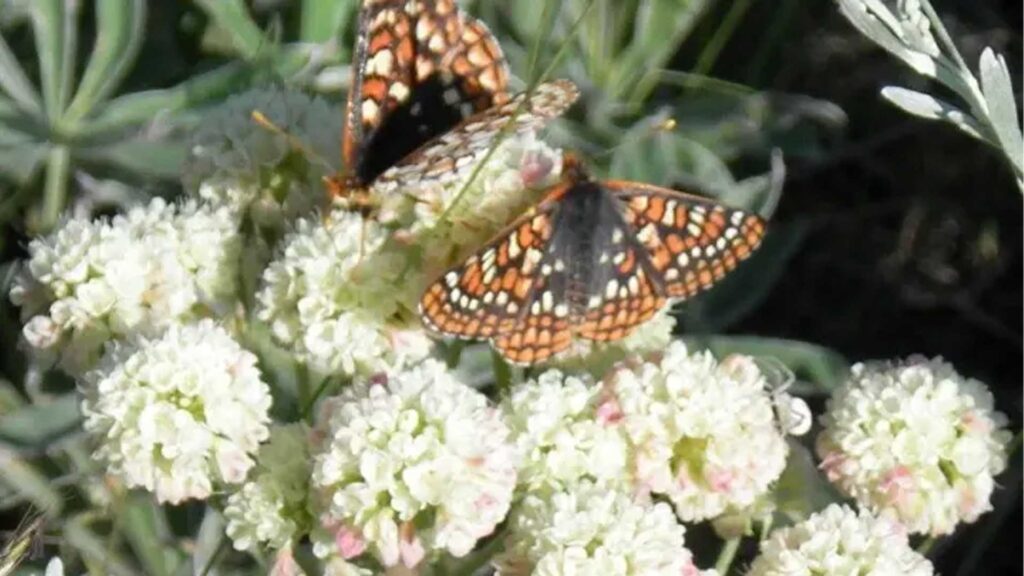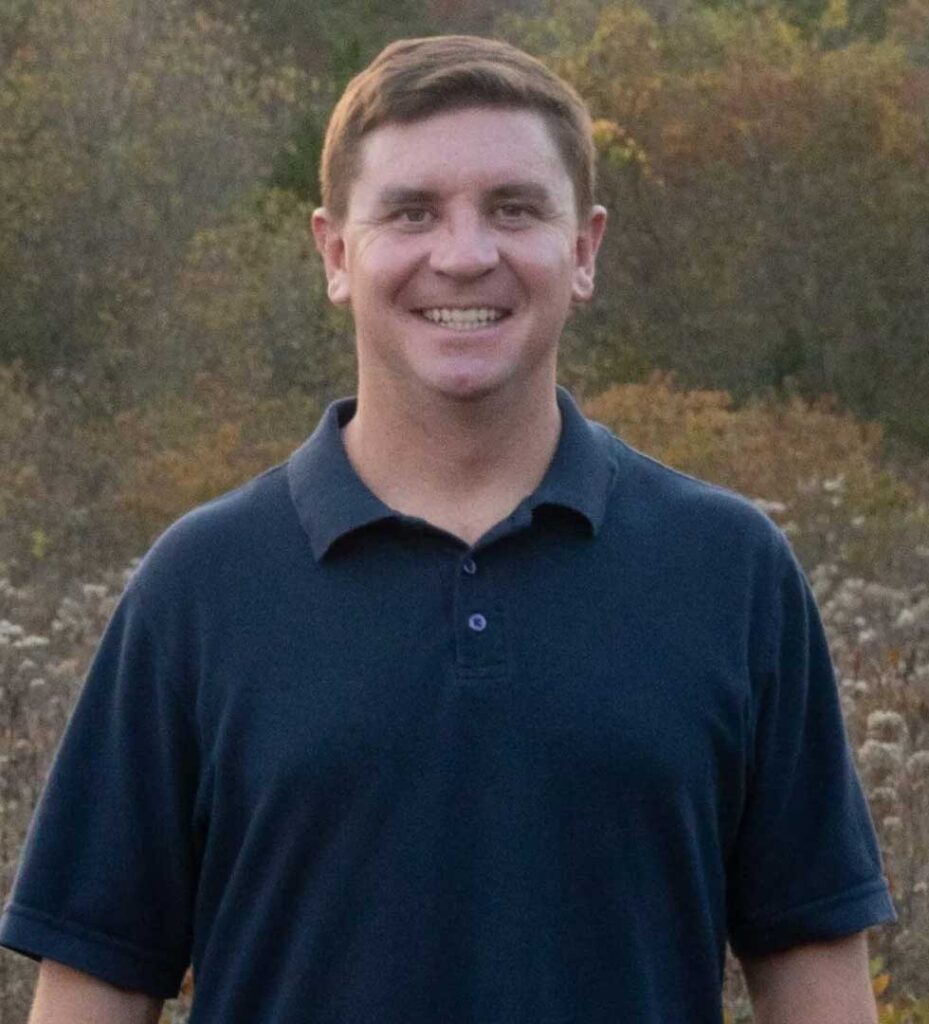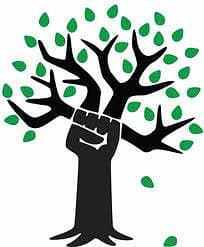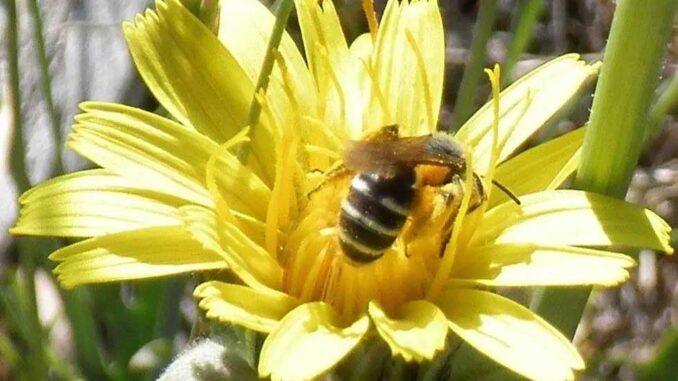
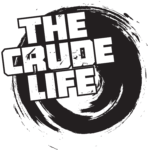
Former University of Wyoming PhD student Mike Curran, Abnova Ecological Solutions, joined Jason Spiess to discuss innovation in energy reclamation.
Curran examined 28 reclaimed well pads in the two Green River basin gas fields from 2015 to 2017. The first study, focused on the Anticline, found a surge of bug numbers and families where native grasses were planted on reclaimed well pad ground — and even greater gains where Rocky Mountain bee plant was seeded.
A subsequent study, examining infill drilling sites on the more southerly Jonah Field, suggests that native, flowering vegetation planted on rehabilitated ground provided nodes of seasonal habitat for pollinator insects that were well occupied relative to undeveloped sagebrush.
Abnova Ecological Solutions is owned and operated by Ecologist, Dr. Michael Curran. Dr. Curran is a Certified Ecological Restoration Practitioner (CERP) and received both the top M.S. and top Ph.D. Student Award in the country by the American Society of Reclamation Sciences upon completing his graduate degrees.
He developed techniques to improve reclamation & restoration monitoring which not only improve data quality, but also reduce field time by 10-40x (depending on if handheld or drone imagery is used). He also pioneered the use of spatially-explicit dashboards to rapidly report reclamation monitoring results, allowing for informed decision making and easy-to-interpret data.
Dr. Curran worked with 26 oil & gas companies in reporting reclamation and restoration data to the US Fish & Wildlife Service’s Conservation Efforts Database prior to the 2015 Endangered Species Act listing decision of the Greater sage-grouse and was acknowledged by the USFWS for the importance of his contributions. He has experience transitioning the reclamation monitoring and reporting techniques he developed to conservation bank monitoring.
Dr. Curran has experience developing reclamation plans which go beyond satisfying regulatory criteria towards restoring food webs and creating pollinator and wildlife habitat. Aside from holding a PhD in Ecology, Dr. Curran has a Master’s degree in Rangeland Ecology & Watershed Management and a Graduate Minor in Statistics.
Prior to graduate school, Dr. Curran worked in documentary video with experience covering social and environmental issues. After graduate school, he took a post-doc research position in Mississippi studying how drones can be used to monitor wildlife and then worked at a large plant nursery in New Jersey, growing and selling native plants to restore ecosystem services in suburban landscapes. Dr. Curran has given workshops or been a presenter at over 65 conferences or symposia throughout the United States and Canada.
He is Editor of Reclamation Matters, and Associate Editor for Natural Areas Journal and Reclamation Sciences. Dr. Curran has been an ocean lifeguard since 2002 and is a member of the Southern Monmouth After-Hours Rescue Team (S.M.A.R.T.) for open water emergencies.
Below is the raw, unedited transcript from our artificial intelligence translator.
Jason Spiess
Alright, let’s talk a little bit about ecological solutions in oil and gas and energy. How is it that you know with the crude life will start there with the crude life. How is it that your product your company is involved with oil and gas. But first you know you better at least give an overview of what your company does more. The elevator pitch. We’ll get into some of the uh specifics as the interview goes, but describe your company and how it inter relates with oil and gas.
Michael Curran
Yeah, Abnova Ecological Solutions is a general ecology solution company. I focused mainly on reclamation and restoration and a lot of habitat conservation and things like that. We have a broad background in anything from data management, geographic information science services to real ecological science. I do most of the operations and have a PhD in ecology from the University of Wyoming.
During my time there I worked with 26 oil and gas companies to develop a large database system tracking reclamation and restoration efforts, things like seed mixes, herbicide applications and so on and so forth as well as their outcomes. With that I’ve pioneered several techniques to monitor reclaim sites using cell phones or handheld cameras, or using drones. All interrelated with mapping tools.
And then really one of the other things I specialize in is developing seed mixes and soil amendments and reclamation plans. And then more recently I’ve gotten into just tracking how the ecosystem services respond to these efforts. And with that I think there’s definitely a lot of benefit that these oil and gas companies can have when they’re doing really large reclamation jobs.
Jason Spiess
What are some of the things that you saw positive come out of this?
Michael Curran
Yeah. So one of the recent studies are two of the recent studies that were published in 2022 were related to how insects respond to oil and gas development and subsequent reclamation. We were utilizing seed mixes with an early seral species called Rocky Mountain bee plant. That’s a native annual flower that typically not used because companies haven’t gotten bond release from using annual species, they don’t use them.
What we find with that species specifically is it does a really good job at competing with the invasive and noxious weeds in in Wyoming. So actually companies, by utilizing that species are gonna be saving money in their reclamation plan by reducing herbicide costs and so on and so forth. It really started being used as that.
So there’s that whole major benefit. It competes with noxious and invasive weeds. It grows taller than the native sage brush. It’ll retain moisture in the first year to provide evaporation, transpiration benefits and shade benefits for other later seral species. So allows the perennial stuff and those seed mixes to kind of come in and two or three years after initial seeding while that native plant drops out of the mix.
Yeah well within, you know, maybe 5 to 7 years we’re actually starting to see soil carbon at the same levels or higher than what it was previously or compared to adjacent reference systems. So there’s all those benefits. And then I really wanted to look at what what’s going on with the insect world. And the reason for that is insects are you know, part of the animal kingdom and they are wildlife.
But really insects provide more ecosystem services than any other form of wildlife. They’re the foundation for terrestrial food webs with 96% or more of terrestrial bird species utilizing insects as their primary source of protein, especially at the chick stage. Insects also provide the vast majority of pollinator services on earth.
And that’s definitely one of the most important parts of a restoration or reclamation program is bringing pollinators in that can help with reproduction of the plants that you just seeded so that they can set seed and you can have a self-perpetuating community. And then they do a whole bunch of other things like, you know, obviously a huge source of biodiversity. They do a lot for nutrient cycling, bio control and things of that sort.
So in this instance um and it’s pretty common to actually use insects as indicators of ecosystem functionality in both aquatic and terrestrial systems. But yeah in this instance if we were looking at insect biodiversity insect abundance it looks as though the these reclaimed well pad locations are very much so higher functioning ecosystems then what they were before or what the surrounding vegetation communities are.
Jason Spiess
Now when we’re talking about you know some of the things that they can improve some of the things that you may have uh noticed that you’re gonna be working on or are currently working on when it comes to reclamation. We’re talking about being proactive here. Uh What areas of proactive nous or in a proactive nature are you seen that either your company can bring to the table or you know maybe it’s a different company maybe it’s you know something in you know outside of the seed in
ecological maybe it’s something in the I. T. World that can be brought into the fold. Um What are you seeing in terms of being proactive or the industry could be more proactive because this is an area that it never seems that you can be proactive enough.
Michael Curran
Yeah so a lot of this comes from the planning stages and I think companies are getting a lot more proactive and where they’re siting their disturbances. So where they’re placing their well pads, how their routing their pipelines. You know there’s been a ton of work there a lot of that comes down to just simple G. I. S. Exercises.
My company could definitely help with a lot of it. You know these companies are working with government agencies, with NGOs, where to put their pads and where to put their disturbances. So that’s probably the first step of it. Um The second thing is I think up until you know maybe seven or eight years ago when the greater sage-grouse really became this is in you know the Rocky mountain states where the sage grouse became uh the species of concern for endangered species listing reclamation had typically been to control erosion and to prevent weeds. Now it’s I think moving towards reclaiming and restoring wildlife habitat. So yeah companies definitely when they are siting their locations, minimizing their soil disturbances, handling soil properly, are huge steps. Working with someone to help tailor their seed mixes rather than just you know call a seed company and get the reclamation 101 mix putting a ittle bit of effort in the up-front there can go a long way not only in cost savings but in an output and in providing benefits to wildlife and other ecosystem services. So there’s a lot there. One of the things that I’ve got really into is that monitoring and developed ways to monitor these sites that were with handheld devices typically about 10 times faster than traditional techniques. And providing really good spatial information. In 2020 I started doing stuff with drones actually in 2018 and 2019. I published the first paper to look at how to use drones to monitor reclamation in 2020 where we’re about 40-45 times faster than traditional methods. Why does that become proactive? Because it’s actually giving these companies a fast way to capture information out in the field. And then I’ve pioneered the use of spatially explicit dashboards for all of this stuff. So these companies can get either real time, close to real time, or much more rapid reports and decision making tools and they’ve previously gotten. So yeah, with that for example, one of the companies out in Wyoming is saving on an annual basis, about $135k, a year. Just in making better decisions on where and when to spray herbicide. So that that kind of all leads to a domino effect of saving money reducing your herbicide spray but you’re also making better decisions as to where to spray it, in turn reducing the amount of chemicals you’re putting out, probably having direct benefits to pollinators and other species that are harmed by chemicals, and getting much more better results from the reclamation and restoration.
Jason Spiess
All right talk to me like I’m a ceo talk to me like I’m a decision maker. I’m a legislative body member, politician, nonprofit in charge of helping reclamation. You know, those types. Um, why why is it that you are bringing a solution to the, you know, the table, so to speak? Um, you know, and, and basically if you had an elevator pitch of five floors, six floors, you know, a couple of minutes you had in an elevator with someone, how would you convince a lobbyist or a state legislature that,
you know, you are part of the solution? Because I gotta be honest, man, everybody seems to be coming forward with a new idea to help with the environment that there’s a lot of noise out there, if you know what I mean?
Michael Curran
Sure. Yeah. So we’re in the, what the United Nations is calling the Decade on Ecosystem Restoration, which is 2021 to 2030 saying we’ve got to do a whole lot on restoring ecosystems in this next decade to reverse things like biodiversity loss, to help with climate change, and so on and so forth. Oil and gas provide very tangible benefits that that we need to use, especially with growing populations.
So as more extraction happens, more surface disturbances are occurring, it doesn’t make sense for oil and gas to not be part of the solution. And in many instances I think we can look at oil and gas is analogous to natural disturbances, maybe like a wildfire or things like that, that really kind of can reset or rejuvenate native ecosystems.
So I think if we look at it that way and put the right resources in, we can have huge benefits. And because of the amount of surface disturbance there is out there associated with oil and gas, it doesn’t make sense not to be part of the solution.
Jason Spiess
So let’s talk a little bit about, you know, what it is that you do for, you know, what’s next. So let’s say somebody engages with your service talk about, you know, the first week. What happens?
Michael Curran
Yeah, so I’ll work with companies on just kind of assessing what their disturbance looks like, where they’re at, where they’ve been, how I can help them make better decisions, what they’ve got kind of coming up the the pipeline, what disturbances are gonna be done in the next year or so, or where they’ve been seeing failures and I’ll work with them specifically how to address that.
And then, from there, we’lllook at things like what wildlife are utilizing these areas, what kind of problems do you have in these areas. How can we work together um Right from the get go to minimize our impact. And yeah a lot of this stuff we can build out a good reclamation plan from the beginning that’s gonna save a ton of time and money over the life cycle of maybe a well pad or a pipeline. If we can get it right from day one, we’re gonna be saving tens, if not hundreds of thousands of dollars on redoing soil work, redoing or having to apply herbicides, and things like that. So oftentimes what I’m looking at is where our companies at and what some of their goals are um what their practices have been and then and working on solving the big problems that they have and then just streamlining the way their whole operations can work.
Jason Spiess
Now you’re in Cheyenne, Wyoming, University of Wyoming is where you got your education um This uh study on the bees and some of that different thing that was out of Wyoming correct. That was where you did your work.
Michael Curran
Yes. One of the studies that was published in April 2022 was in the Pinedale Anticline Gas Field. And then a more recent study came from the Jonah Field. So just south of Pinedale.
Jason Spiess
Okay now I was gonna ask you now do you do business in any other states or is it just primarily Wyoming or are you looking to branch out and uh other areas now that the studies done. Talk to me a little bit about your current business and your aspirations.
Michael Curran
Yeah. So I actually have a few clients in Colorado, now oil and gas wise, I’m also talking to some folks in Texas. and then I, yeah, I do other ecology work working with some pipeline companies out in the Appalachian world, Pennsylvania, Ohio and a lot of this stuff I I can take just general ecology principles and I think transfer them across the board. But yeah, right now I’m focused kind of in the Rocky Mountains.
I’m starting to branch out into Appalachia a little bit. And then, yeah, I also work with different types of disturbances. I do a lot of work with abandoned mines out in Wyoming and yeah, out east more kind of coastal resilience and coastal habitat restoration type of stuff. So I’m pretty broad and right now oil and gas work in the Rocky Mountains is expanding.
Jason Spiess
What’s the takeaway from this interview? What do you want people to take away from this? …
Michael Curran
Yeah, I’d say … if you look at a lot of what’s on the news almost every day, I’ll read something about pollinator decline or extinction or the sixth extinction coming, or climate change. All this stuff. I think that ecological restoration is going to be increasingly important tool to combat or to mitigate a lot of these global environmental threats that we hear about all the time. And yeah, the stuff that I showed in Pinedale and in the Jonah field, I mean we found 22 times more insects and pollinators just by doing a good job getting native plants growing back on these disturbed sites. So yeah, I think if we put some thought into this and do it right that the oil and gas industry can really do a good job helping solve some of these environmental problems. And yeah, I’m looking forward to working with more and more companies as there’s more and more of a push for that to happen.
Submit your Article Ideas to The Crude Life! Email studio@thecrudelife.com
About The Crude Life
Award winning interviewer and broadcast journalist Jason Spiess and Content Correspondents engage with the industry’s best thinkers, writers, politicians, business leaders, scientists, entertainers, community leaders, cafe owners and other newsmakers in one-on-one interviews and round table discussions.
The Crude Life has been broadcasting on radio stations since 2012 and posts all updates and interviews on The Crude Life Social Media Network.
Everyday your story is being told by someone. Who is telling your story? Who are you telling your story to?
#thecrudelife promotes a culture of inclusion and respect through interviews, content creation, live events and partnerships that educate, enrich, and empower people to create a positive social environment for all, regardless of age, race, religion, sexual orientation, or physical or intellectual ability.
Sponsors, Music and Other Show Notes
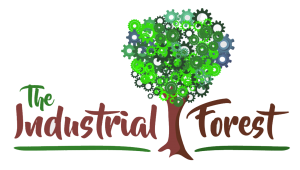
Studio Sponsor: The Industrial Forest
The Industrial Forest is a network of environmentally minded and socially conscious businesses that are using industrial innovations to build a network of sustainable forests across the United States.
Weekly Sponsor: Stephen Heins, The Practical Environmentalist
Historically, Heins has been a writer on subjects ranging from broadband and the US electricity grid, to environmental, energy and regulatory topics.
Heins is also a vocal advocate of the Internet of Everything, free trade, and global issues affecting the third of our planet that still lives in abject poverty.
Heins is troubled by the Carbon Tax, Cap & Trade, Carbon Offsets and Carbon Credits, because he questions their efficacy in solving the climate problem, are too gamable by rent seekers, and are fraught with unreliable accounting.
Heins worries that climate and other environmental reporting in the US and Europe has become too politicized, ignores the essential role carbon-based energy continues to play in the lives of billions, demonizes the promise and practicality of Nuclear Energy and cheerleads for renewable energy sources that cannot solve the real world problems of scarcity and poverty.
Look at what’s happened to me.
I can’t believe it myself.
Suddenly I’m down at the bottom of the world.
It should have been somebody else
Believe it or not, I’m walking on air.
I never thought I could feel so free-e-e.
Barterin’ away with some wings at the fair
Who could it be?
Believe it or not it’s just me
The Last American Entrepreneur
Click here of The Last American Entrepreneur’s website
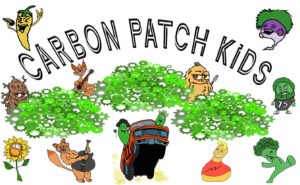
Studio Email and Inbox Sponsor: The Carbon Patch Kids
The Carbon Patch Kids are a Content Story Series targeted for Children of All Ages! In the world of the Carbon Patch Kids , all life matters and has a purpose. Even the bugs, slugs, weeds and voles.
The Carbon Patch Kids love adventures and playing together. This interaction often finds them encountering emotional experiences that can leave them confused, scared or even too excited to think clearly!
Often times, with the help of their companions, the Carbon Patch Kids can reach a solution to their struggle. Sometimes the Carbon Patch Kids have to reach down deep inside and believe in their own special gift in order to grow.
The caretakers of Carbon Patch Kids do their best to plant seeds in each of the Carbon Patch Kids so they can approach life’s problems with a non-aggressive, peaceful and neighborly solution.
Carbon Patch Kids live, work and play in The Industrial Forest.
Click here for The CarbonPatchKids’ website

Featured Music: Alma Cook
Click here for Alma Cook’s music website
Click here for Alma Cook’s day job – Cook Compliance Solutions
For guest, band or show topic requests, email studio@thecrudelife.com
Spread the word. Support the industry. Share the energy.

